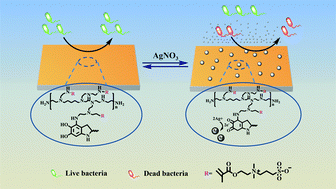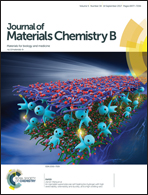Co-deposition towards mussel-inspired antifouling and antibacterial membranes by using zwitterionic polymers and silver nanoparticles†
Abstract
Bacterial attachment and the subsequent colonization on the surfaces of bio-materials usually result in biofilm formation, and thus lead to implant failure, inflammation and so on. Herein, a novel mussel-inspired antibacterial and antifouling membrane was designed via co-deposition of polydopamine (PDA) and a zwitterionic polymer, followed by incorporating bactericidal silver nanoparticles (Ag NPs). Polyethyleneimine-graft-sulfobetaine methacrylate (PEI-SBMA) was firstly co-deposited onto a polyethersulfone (PES) membrane surface via crosslinking with PDA to construct an antifouling surface. Then, Ag NPs were in situ synthesized on the membrane surface without adding any external reducing agents. Elemental and morphological surface analyses confirmed the successful co-deposition of PEI-SBMA onto the PES surface and the successful reduction of silver ions by the PDA layer. In addition, the PEI-SBMA could significantly reduce Ag NP aggregation, and the modified surface exhibited sustained bactericidal activity and effective inhibition of bacterial adhesion. This demonstrated that the proposed approach was straightforward to fabricate mussel-inspired antifouling and antibacterial membranes, which showed great potential to be used in biomedical fields.



 Please wait while we load your content...
Please wait while we load your content...